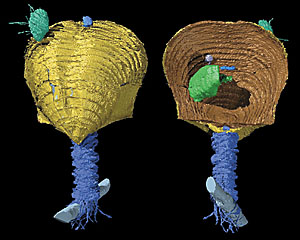 | Scientists' digital reconstruction of a "Lamp Shell" buried in volcanic ash eons ago shows both its soft parts (blue) and the smaller creatures (green) attached to it. |
A team of American and British scientists have identified and digitally reconstructed the first example of a fossilized brachiopod complete with its pedicle, the stalk attaching it to the sea floor, and its lophophore or feeding organ, according to a report in the journal Nature.
Brachiopods, the so-called "lamp shells," are rare today, but are some of the best known fossils from the Paleozoic era, 542 to 251 million years ago. Scientists' knowledge of these extinct forms was previously based almost entirely on their shells, which are all that normally fossilize.
Derek Briggs, professor of geology and geophysics and director of the Yale Institute of Biospheric Studies, conducted the research on the fossil deposits in Herefordshire, United Kingdom, along with his colleagues Mark Sutton of Imperial College, University of London; Derek Siveter of the University of Oxford; and David Siveter of the University of Leicester.
The trove of fossil records was buried under the sea in volcanic ash that is 425 million years old. The site is unusual because it yields fossils of the entire animals, including soft body parts that the researchers then can reconstruct digitally.
"This specimen is particularly interesting as several smaller brachiopods have attached themselves to its shell, two of them also preserving pedicles," says Briggs.
The brachiopod belongs to an extinct group, and this work reveals that its pedicle differs from that on living forms. Previous assumptions that extinct brachiopods were very similar to modern examples may thus be too simplistic, say the researchers.
Other specimens of interest from the volcanic ash at Herefordshire that were recently reconstructed by the team include an ancient sea spider and the oldest fossil animal that is "definitively male."
This work was supported by the Leverhulme Trust, Natural Environment Research Council and English Nature.
-- By Janet Rettig Emanuel
T H I S
Team digitally reconstructs
long-extinct 'Lamp Shell' W E E K ' S
W E E K ' S S T O R I E S
S T O R I E S![]()
 Margaret Grey is named dean of School of Nursing
Margaret Grey is named dean of School of Nursing![]()
![]()
 Benson to step down as dean of School of Art after this year
Benson to step down as dean of School of Art after this year![]()
![]()
 Team discovers new planet in the outer solar system
Team discovers new planet in the outer solar system![]()
![]()
 Grant will fund center for study of nervous system
Grant will fund center for study of nervous system![]()
![]()
 Study: Alligator eggs show effect of oxygen on development
Study: Alligator eggs show effect of oxygen on development![]()
![]()
 Yale Librarian Prochaska appointed to a second term
Yale Librarian Prochaska appointed to a second term![]()
![]()
 New master's program prepares nurses for leadership roles
New master's program prepares nurses for leadership roles![]()
![]()
 Exhibit explores the 18th-century 'worlds' of Francis Wheatley
Exhibit explores the 18th-century 'worlds' of Francis Wheatley![]()
![]()
 Private portrait miniatures showcase the faces of public figures
Private portrait miniatures showcase the faces of public figures![]()
![]()
 Gallery hosting festive open house . . .
Gallery hosting festive open house . . .![]()
![]()
 Architecture gallery to feature traveling art show 'Ant Farm'
Architecture gallery to feature traveling art show 'Ant Farm'![]()
![]()
 Sterling Library launches new academic year with two exhibits
Sterling Library launches new academic year with two exhibits![]()
![]()
 Researchers create powerful tool for decoding gene functions
Researchers create powerful tool for decoding gene functions![]()
![]()
 Galapagos tortoises more diverse than once believed, say scientists
Galapagos tortoises more diverse than once believed, say scientists![]()
![]()
 Team identifies 'signatures' of protons in water
Team identifies 'signatures' of protons in water![]()
![]()
 'Canary Database' shows animals offer health warnings for humans
'Canary Database' shows animals offer health warnings for humans![]()
![]()
 Team digitally reconstructs long-extinct 'Lamp Shell'
Team digitally reconstructs long-extinct 'Lamp Shell'![]()
![]()
 'Gene trapping' reveals how flower development is controlled
'Gene trapping' reveals how flower development is controlled![]()
![]()
 Discovery may aid development of treatment for melanoma
Discovery may aid development of treatment for melanoma![]()
![]()
 Drinking alcohol may lower risk of non-Hodgkin's lymphoma
Drinking alcohol may lower risk of non-Hodgkin's lymphoma![]()
![]()
 Lyme disease prevention program launched in Connecticut
Lyme disease prevention program launched in Connecticut![]()
![]()
 For 35 students, summer was a time of service in New Haven
For 35 students, summer was a time of service in New Haven![]()
![]()
 IN MEMORIAM
IN MEMORIAM
 John Ostrom: He revolutionized field of paleontology
John Ostrom: He revolutionized field of paleontology![]()
 Robert Abelson: Psychologist was adviser to presidential candidates
Robert Abelson: Psychologist was adviser to presidential candidates![]()
 Greer Allen: University printer was inspiration to School of Art students
Greer Allen: University printer was inspiration to School of Art students![]()
![]()
 Yale Books in Brief
Yale Books in Brief![]()
![]()
 Campus Notes
Campus Notes![]()
Bulletin Home |
| Visiting on Campus
Visiting on Campus |
| Calendar of Events
Calendar of Events |
| In the News
In the News![]()
Bulletin Board |
| Classified Ads
Classified Ads |
| Search Archives
Search Archives |
| Deadlines
Deadlines![]()
Bulletin Staff |
| Public Affairs
Public Affairs |
| News Releases
News Releases |
| E-Mail Us
E-Mail Us |
| Yale Home
Yale Home